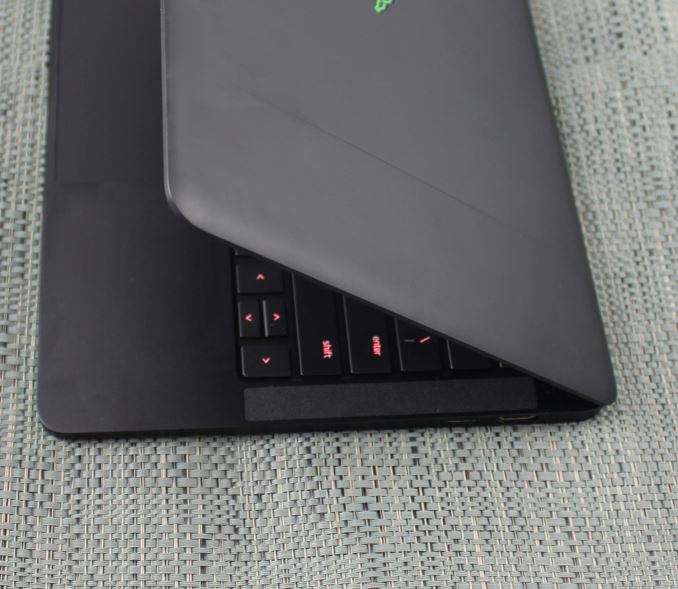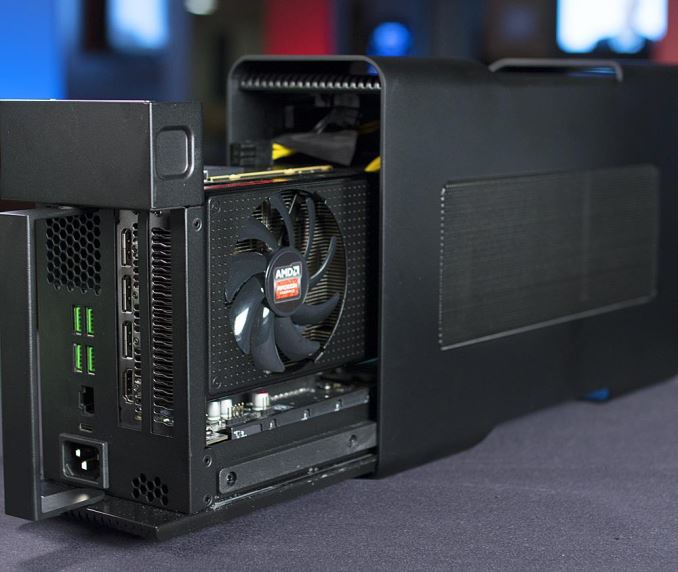The Razer Blade Stealth Review: Razer Takes On The Ultrabook
by Brett Howse on March 29, 2016 8:00 AM EST- Posted in
- Laptops
- Razer
- Skylake
- Razer Blade Stealth
- eGFX
- Razer Core
- Skylake-U
Final Words
So what is the verdict on Razer’s first step into the Ultrabook world. As with most devices, they’ve done some things well, some things great, and some things not so great. The first great part is the design. The Stealth is basically a mini-version of the Blade 14, with an almost identical look and feel. The matte black finish looks wonderful on the CNC aluminum chassis, at least until it gets a few fingerprints. Razer has put their same hidden cooling vent into the hinge of the notebook, concealing it from view for a cleaner overall look, and other than the green Razer light-up logo, the design is very understated which is something that has its own appeal.
The keyboard is a marvel of engineering. Razer is certainly not the first company to do a backlit notebook keyboard, or even a backlit keyboard that can change color, but they are the first to do individual backlit RGB keys on an Ultrabook, and the result is spectacular. The Razer software lets you pick several stock options for colors and patterns, or you can use the Chroma Configurator to set pretty much anything you want. It is completely customizable, and this is something that’s been on the desktop space for some time, and it’s great to see it come to the notebook.
Razer has also outfitted the Stealth with one of the highest density displays around. Packing a UHD resolution into a 12.5-inch panel may seem like overkill, but side by side with the QHD version the difference is very apparent. It is also a full Adobe RGB gamut panel, which has an up-side in a much wider color gamut, but is also a downside due to the lack of good software support from Windows.
The performance of the Intel Core i7-6500U CPU is very good, and with the Stealth there are no lower tiers in terms of performance. Most devices charge a lot more for the Core i7 model, so it’s great to see Razer include it across all models. I do feel that an Iris based processor would have been nice, even as a more expensive option, but that is not in the cards with the first generation, at least for now. Otherwise the 8 GB of RAM is adequate for today, but with Skylake’s support of DDR4, 16 GB of RAM in an Ultrabook is quickly becoming the new normal. Storage performance is very good across the range, with all Stealths coming with NVMe PCIe storage. It’s a slower TLC SSD, but it still outclasses the SATA drives of last year.
Meanwhile Razer has also put a lot of engineering into the Stealth so that it could be used in conjunction with the Razer Core. This will be the world’s first external graphics dock over Thunderbolt 3, and they had to work closely with the entire Windows ecosystem crew – AMD, NVIDIA, Intel, and Microsoft – to enable this functionality in as seamless a method as possible. The Core is coming out this month, and will give a single-cable docking solution to significantly increase the graphical power of this device. At CES, I was able to see the Stealth attached to Core running Fallout 4, and it was a great experience. That said, I’m curious to see how much the U series processors hold back a really fast GPU, but regardless the experience is going to be a lot better than the limited graphics power you can fit in an Ultrabook.
In terms of construction, the Razer Blade Stealth really has everything done well. A great aluminum chassis, a thin and light design, and a top notch display. It has a great new keyboard lighting system, and support for external graphics over Thunderbolt 3. It even uses USB-C as the charging port, meaning the same cable that can charge your phone can charge the Stealth. There’s just one issue with it, and unfortunately it’s a big one.
Simply put, the battery life of the Stealth is not up to snuff with the rest of the Ultrabook competition. I knew going in that a UHD display with Adobe RGB support was going to hit the battery life hard, but I was a bit surprised just how poorly it fared. Even switching out displays for the lower-resolution sRGB QHD panel can't fully close the gap. If Razer wants to compete against the big OEMs in the Ultrabook space, they need to look at every single component in the Stealth, and find ways to save power on all of them. Eight hours is really the minimum on our light test for 2016, and even the QHD version falls well short of that.
It's really too bad, because the rest of the Stealth is a top notch laptop. Which does't have us writing off the laptop entirely – there are plenty of cases where it might still be a great machine – but if any scenario involves long periods away from a power outlet, it’s going to be an issue. Sure you can supplant it with USB battery packs, or find a place to plug in, but that’s not always a practical option.
Ultimately the Razer Blade Stealth is so close to being an awesome Ultrabook. If you don’t need battery life, you’ll want to check it out, but if you do value longer run times off of the battery, the Stealth is likely not the laptop for you.












66 Comments
View All Comments
foxalopex - Tuesday, March 29, 2016 - link
I think the only difference I would like to see in this Ultrabook is a more powerful CPU / Intel GPU built in complement making it a slightly higher end mobile laptop. The external add on GPU would then make it perfect for home gaming uses. I suspect I'll have to wait for the next generation of units to see if this happens.vanilla_gorilla - Tuesday, March 29, 2016 - link
I would never buy it based on the logo alone, but I'm an adult. As long as they know they're ceding that market segment, then I wish them the best of luck.T1beriu - Tuesday, March 29, 2016 - link
Typo: " Even switching out displays for the lower-resolution sRGB UHD [QHD?] panel can't fully close the gap."Ryan Smith - Tuesday, March 29, 2016 - link
Yep, right you are. Thanks.nerd1 - Tuesday, March 29, 2016 - link
Returned mine as it barely lasted 4 hours with active usage (web browsing with chrome)And screen is too small due to huge bezel, whole laptop is fingerprint magnet due to the finish. Avoid this.
will1956 - Tuesday, March 29, 2016 - link
to be fair Chrome is great but it is a resource hognagi603 - Tuesday, March 29, 2016 - link
to be fair I could get 4 hours of browsing out of a 2004 laptop. This laptop has the price of a high-end ultrabook, but not the actual features that would want you to buy an ultrabook.mrvco - Tuesday, March 29, 2016 - link
Razer Core is the only thing that makes this laptop interesting in any sort of practical sense. I gave up on gaming laptops a long time ago and left gaming to my desktop Windows machine. If you use Windows for both work and play, then I could see the Blade Stealth w/ Core as a replacement for a separate laptop and desktop gaming PC... that is assuming you're ok with limited gaming performance when away from the desk... oh, and the combined price in the neighborhood of $2,500 once you throw in a $300'ish video card.danjw - Tuesday, March 29, 2016 - link
Are you expecting to have a review of the new Razer Blade 14? To me that seemed the much more compelling product.zeeBomb - Tuesday, March 29, 2016 - link
Y u surprise me like that